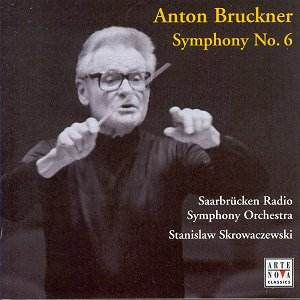 |
Anton BRUCKNER (1824-1896)
Symphony No. 6 in A major Rec 3 & 4 March 1997, Kongresshalle, Saarbrücken Crotchet AmazonUK AmazonUS Amazon recommendations |
The first complete performance of the Symphony no. 6 took place three years after the composer's death, when Gustav Mahler conducted a heavily cut version in Vienna. The music made little headway in its early years, with the result that it does not suffer from the complications of different performing editions which dog so many of Bruckner's works. When he composed it, around 1879, he had suffered many disappointments as a composer, but enjoyed few triumphs. Yet posterity has confirmed that the music he created remained masterly, even visionary.
The recorded music catalogue boasts more good performances of the Symphony now than used to be the case a few years ago, and the arrival of this excellent performance on Arte Nova, by the Saarbrücken Radio Symphony Orchestra under Stanislaw Skrowaczewski, strengthens the position still further. Indeed, anyone looking to add the work to their collection could really do no better than to invest in this budget price issue.
The recording was originally made for Saarbrücken Radio in 1997, and it sounds splendid, with fully sonorous climaxes and great clarity and depth too. These things are particularly important in this piece, since Bruckner shows so many deft orchestral touches, not least in the nocturnal scherzo, which is full of subtleties of rhythm and texture. Skrowaczewski paces this music to perfection.
The basic rhythm of the opening movement is difficult to articulate, but here it is clear in outline and beautifully judged in terms of pace. The description in the score is Majestoso (not Maestoso as listed in the rather slender booklet), and Skrowaczewski certainly achieves a notable sense of majesty as the first subject unfolds from fragments to the first full climax. The flowing gesängperiod (song period) moves naturally and fluently out of this. The closing phase is expertly delivered too, with dynamics carefully observed in order to make maximum effect.
This symphony contains one of the great slow movements. The excellent string playing is captured with abundant richness of tone by the recording engineers, and again the dynamic shadings play a full part. For example, the third theme, a hushed funeral march, makes a particularly telling impression.
With its various changes of gear, the final is not without its problems for interpreters; but Scrowaczewski paces and shapes it admirably. When the main theme of the work returns as if to close the book on the whole conception, the effect is powerful, as sonic satisfaction is combined with the deep inner logic of large-scale symphonic argument.
There are few criticisms that can be levelled at this performance. Perhaps the rhythmic outlines might be more strongly drawn in the first movement, perhaps the playing might show more personality when solo lines emerge from the ensemble. But in truth such things hardly matter, since the effect of the whole is so compelling. For this performance offers the listener a wonderful experience, and at bargain price too.
Terry Barfoot